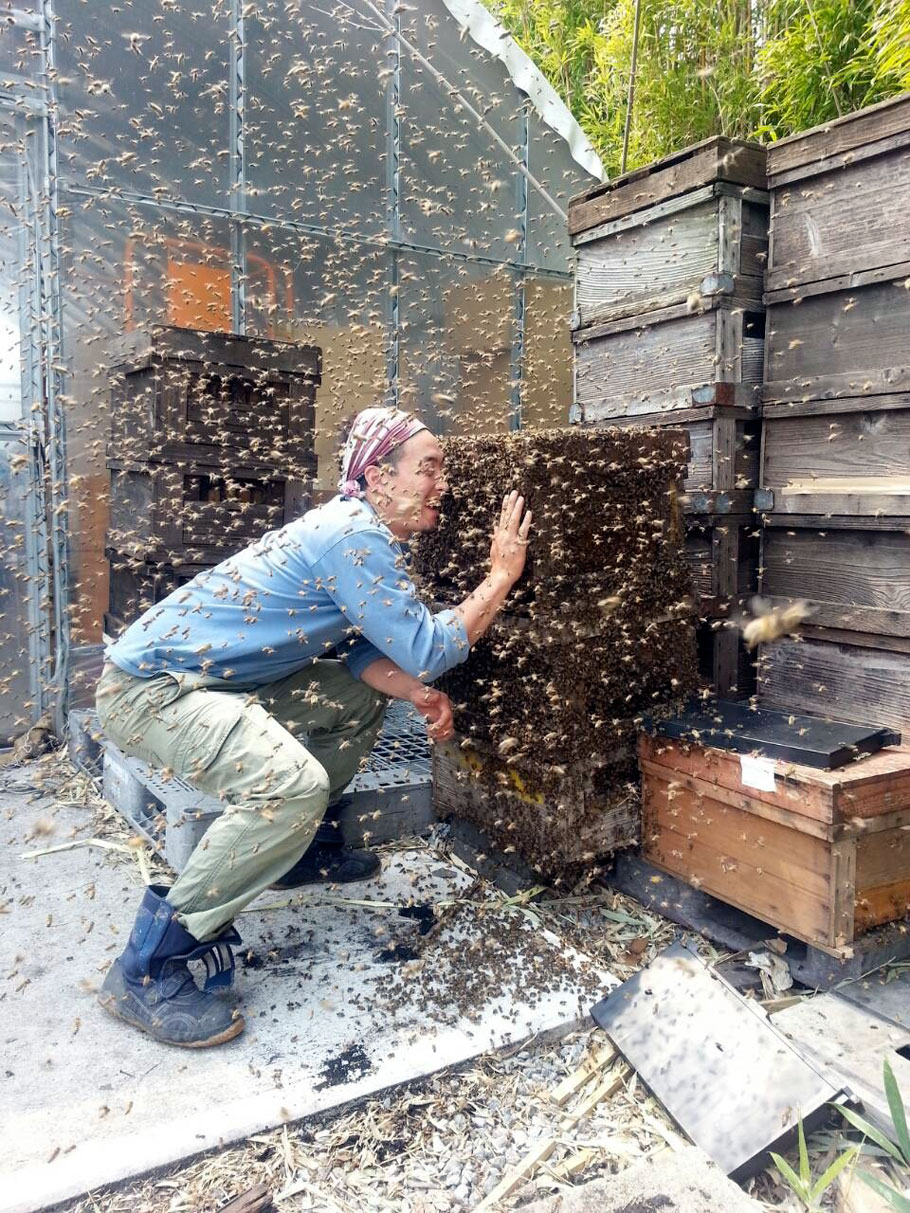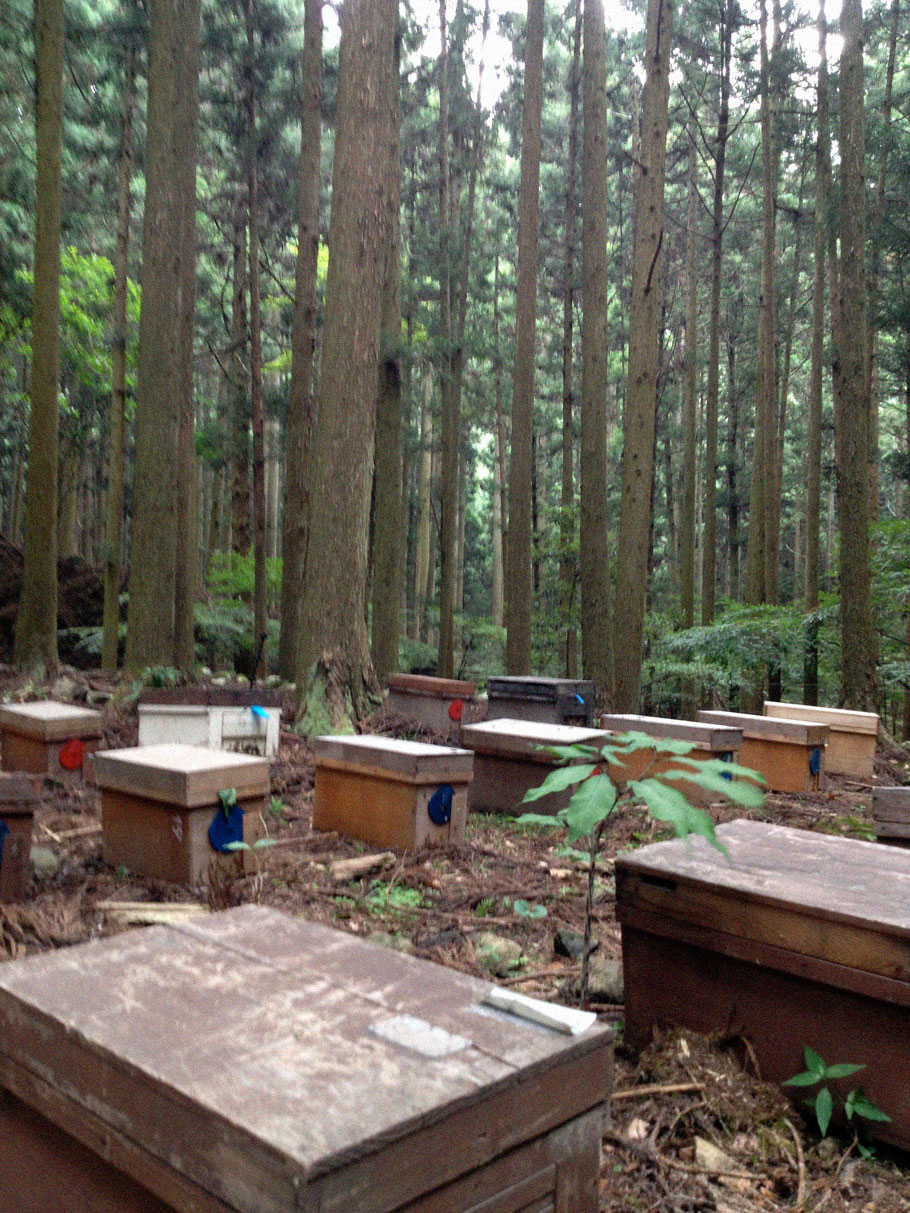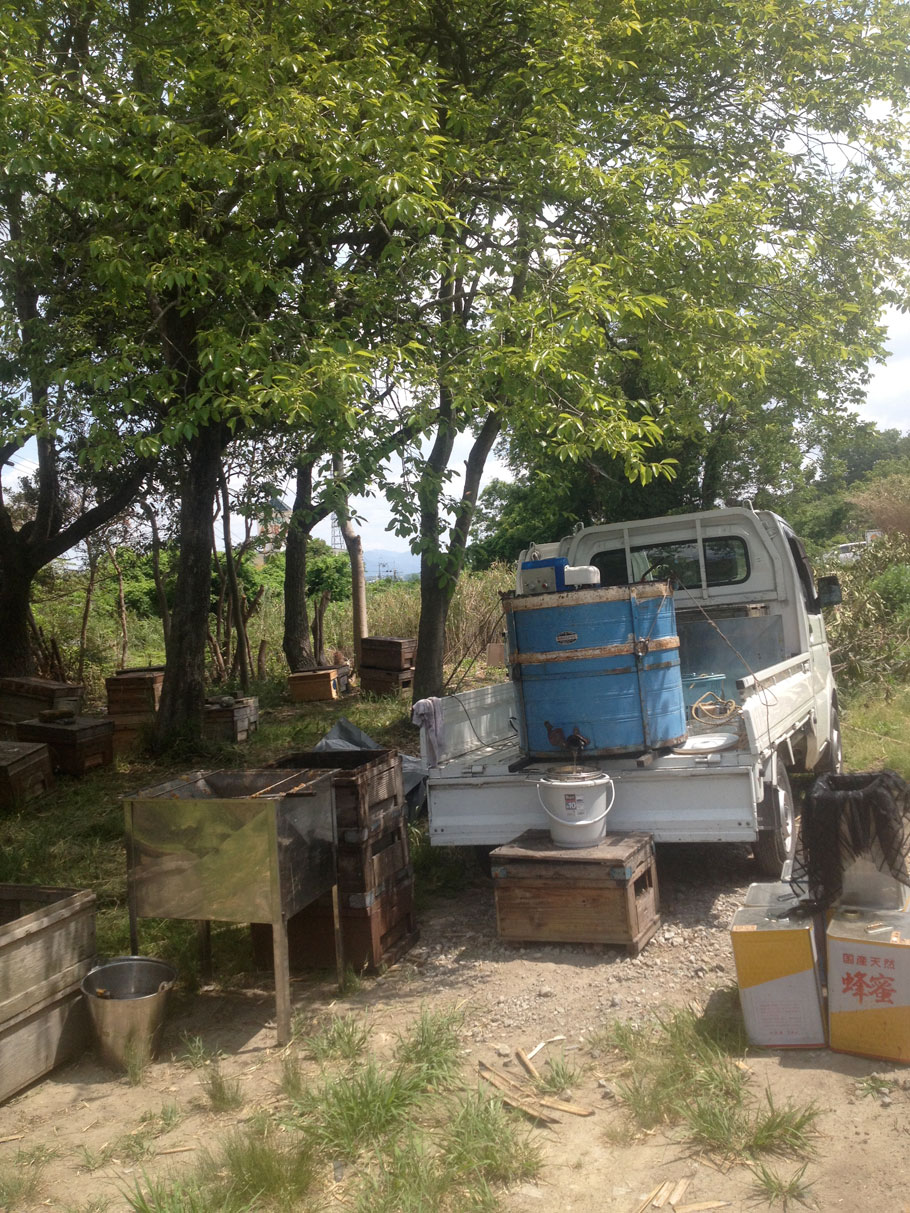Photos and video courtesy of Kunie Kinoshita
There’s something about Kunie Kinoshita’s beekeeping that is instantly engaging - he radiates a charisma; a warm sense of humour. His passion for beekeeping is infectious. And the connection the apiaries he manages have with the natural world of Kobe, Japan, speak volumes about the natural style of beekeeping he practices. Unlike conventional western practices, for example, Kino extracts in the great outdoors, often at the apiary, under big skies (and not in a shed somewhere). Maybe it’s the care and attention to detail he spends on managing his bees - unpainted hives that are painstakingly maintained; a certain pride that is taken in tying down a load of hives with ropes and old school knots (with not a ratchet strap in sight). It’s a bunch of these little things that you respect in a beekeeper and, perhaps, a mix of Western and Japanese beekeeping traditions that he seems to straddle comfortably.

Kino posing with a Japanese yellow hornet nest. This was one of the bigger ones he has removed for clients.
HAWAII
Kino’s beekeeping story started at the beginning of this decade on the island of Oahu, Hawaii. Oahu is the third largest of the Hawaiian islands but is the most populous. The famous city of Honolulu, the state capital of Hawaii, is found on Oahu’s shores. Under the mentorship of former world champ bodysurfer, entomologist and all-round fascinating guru Dr. Michael Kliks, Kino volunteered at the Mona Honey Company in 2011.
And what a great place to start a career in beekeeping. Hawaii’s bee culture runs deep. There are a number of small, medium and large commercial beekeepers practicing a natural method of beekeeping there - some of America’s largest organic apiaries are nestled on those tropical isles.
Both Japan and Hawaii are comprised of a string of islands and I ask Kino how beekeeping compares between the two archipelagos. His response, sadly, cuts to the core of challenges facing commercial apiaries in many parts of the world.
“Hawaii used to be a beekeepers paradise until a few years before I got my start,” Kino explains. “We got the varroa mites (Varroa destructor) in 2007 and in 2011, about one month after I started, we got hit hard with the small hive beetles (Aethina tumida)”.
(I note that Kino’s mentor, Dr. Michael Kliks, was the first to discover mites in Hawaii. When he first saw varroa, as he stood among cut vines he had cleared off an abandoned hive, the good Doctor admits to falling to his knees in tears).
It’s a double whammy for any beekeeping region and Kino explains just what a big impact it has had on tropical Hawaii: “It’s not as easy as it used to be and many old-time beekeepers are having issues adapting to the change. Plus there are no real winters there so the problem is compounded as both pests just thrive year round”.

Kino's Carnis have a strong swarming instinct. He's so happy because they came home : )
JAPAN
In 2012 Kino and his wife made the move to Kobe, Japan, where Kino took up the position of Field Operations Manager with Tawara Apiaries (click here for the google translation). Kobe is the sixth-largest city in Japan and is the capital city of Hyōgo Prefecture on the southern side of the main island of Honshū.
In Japan, Kino notes, “The biggest problem with pests here are the mites and the diseases they transmit. And of course...the hornets! Winters are harsh but I love living through the seasons”.

The Japanese giant hornet. It's big: up to 4.5 cm (1.8 in) long, with a wingspan greater than 6 cm (2.4 in).
HORNETS!
I admit to having a fascination with Japanese hornets and Kino was kind enough to humour me on this. Kino explains that there are two types of hornets that are a bee problem: Japanese yellow hornets (Vespa simillima) and the infamous Japanese giant hornet (Vespa mandarinia japonica).
I was under the mistaken impression that all Japanese apiaries used the Asian honey bee (Apis cerana japonica) as it has developed a natural defense to the hornets: the bees “ball” around the giant hornet and vibrate their flight muscles (in much the same way as they do to heat the hive in cold conditions), increasing the temperature and carbon dioxide concentrations inside the ball to a point where the bees can survive - but the hornet cannot. By comparison, the European honey bee (Apis mellifera) has no such natural defense against the giant hornet. A colony of Japanese giant hornets can decimate a bee colony in one day. They kill the bees, dismember them, and steal the larvae (and choice cuts of the adult bees) to feed their own young.
When I ask Kino about this he clarifies just how he manages European honey bees: “We keep both Carnis (the Carniolan honey bee - Apis mellifera carnica) and Italians (the Italian honey bee - Apis mellifera ligustica) but use mostly Carnis for harvesting honey. They are not quite as defensive as cerana is against the hornets so we have to help them out quite a bit with traps and good old fashioned whacking with badminton racquets and whatnot!”.
Kino also does hornet removals. The hornet nest Kino is wearing in the image above belongs to Japanese yellow hornets. He gets many more calls for removing these guys than he does the Japanese giant hornets. Giant hornets, he points out, live underground and in tree hollows. Kino has been stung by the yellow hornets but has been lucky enough to avoid a sting by the giant hornet - which must be a relief. The stinger of a giant hornet is 6.25 mm-long (or a quarter-inch) and the venom is among the most poisonous of all wasps. Ouch.

An apiary keeping cool, in a Japanese red cedar forest, during Kobe's hot summer.
BEEHIVES
The Italians Kino refers to are used for pollinating crops, such as strawberries in winter. He manages around 250 hives for pollination services and about 120 hives for honey harvesting (with Carniolans). Tawara Apiaries have a very natural approach to their beekeeping which is worth exploring. The hives, for example, are constructed from Japanese red cedar and left unpainted. Unpainted hives - especially internally - are a gold standard in terms of an Australian organic accreditation, but untreated hives are not the norm in Japan.
“Most beeks (beekeepers) here burn the cedar, or put some kind of protective coating on their hives,” Kino explains, “but at Tawara we use them (untreated) until we need to replace them. We end up spending quite a bit of time on repairs though”. This burning of the timber is a traditional Japanese treatment of both hives and cladding on buildings. It does two things: it kills spores and eggs and other pests and also creates a carbonised layer that protects the timber from the weather.
The hives are, more or less, a Japanese edit of a standard Langstroth style but nine frames (as opposed eight and ten in Australia) are the norm. When asked why the Tamara hives are rarely stacked greater than two high Kino replies: “I started working with Italians using queen excluders and stacking them just the way you say. I can only share with you what I’ve learned from my current mentor. He has been in the game for over 30 years and is a third generation beekeeper and a veterinarian by trade. Anyway, he says Carnis have such a strong swarming impulse that it's too difficult to maintain if the colonies use a queen excluder. So we just stack (them as a) a double brood chamber and harvest from around the brood”.
This is yet another great example of the kind of care and attention to detail Kino gives his hives. The usual set-up for a commercial, or even backyard, Langstroth hive is brood box/es on the bottom, and a queen excluder between these and the honey supers on top.
But it is a labour intensive method. It’s not as simple as brushing bees off frames in the honey super and then extracting. It takes much more careful observation and a gentle approach to robbing. Kino really needs to be tuned into what is happening in each hive. “We just need to keep up with the bees and make sure we harvest just before the swarming impulse gets heavy.” When I ask if such an approach gets crazy busy when a good flow is on, Kino explains that they sometimes harvest two times a week from the same colonies! “But there’s only a small window for the good stuff. The acacia season generally only lasts for 2-3 weeks.”

Extracting on site, in the open air. Rarely done in the West, it's very common in Japan.
HONEY!
Acacia (Robinia pseudoacacia) honey is the ‘good stuff’ Kino is referring to (it's also known as 'false' acacia or black locust in the West). This honey is much prized in Japan, China and elsewhere for its light colour and fragrance. I have been lucky enough to try some of this season’s Japanese acacia honey (sadly, it wasn’t some of Kino’s) and it is, truly, amazingly light and delicately fragrant. It has a wonderful golden colour and attracts a golden price: AU$63 per kilo (say US$60 per kilo) shelf price.
Other Japanese honeys of note are buckwheat (or soba - Fagopyrum esculentum) and Kino’s personal favourite, milk vetch (Astragalus sinicus). This is possibly the most expensive and desirable of Japanese honeys. Kino describes it as ‘spectacular’!
As these prices indicate, honey is greatly revered in Japan as both a food and for its medicinal qualities. The extent of this Japanese bee culture is not common knowledge in Australia, so I am excited to learn that the Japanese are so into it. Kino reports that very expensive honey boutiques are now quite a thing in Japan.
At the time of this interview Kino was waiting with bated breath for the acacia harvest but wasn’t confident that it would be a great season. This is always bad news for beekeepers but Tawara have learned to diversify their business to spread the risk. “It seems a lot of apiaries focus mainly on honey, and maybe some wax, but we really do everything! Queen rearing; buying and selling bees from abroad (Carnies from Slovenia, Italians from Australia); pollination; equipment sales; medication. You name it, we do it at some level.”
THE HUMAN SCALE OF THINGS
On reflection, the thing I like most about Kino’s beekeeping is the human scale of things: big enough to be commercial, but small enough to care about each hive. It’s the attention to detail and artisan-like approach that is so engaging. Kino says it best:
“The way we do it - with the ropes as opposed to ratchets and the use of smaller k-trucks (as we call them here) is somewhat tedious and labor intensive but it’s a very interesting and natural way to do things. I can’t really speak for other bee operations, but I know that my boss is a big advocate of keeping things natural and humanly manageable. It may be an old-timer approach but I feel really fortunate that I am able to learn in this fashion and am aiming at keeping my operations on the same scale when I decide to go independent”.
Kunie Kinoshita - I wish you all the best with Tamara and your future plans. If those plans take you back to Hawaii I’d love to document that chapter too!
Tawara Aparies, Kobe, Japan. from Honey Fingers on Vimeo.
Kino's colleague tying down a load of hives on a k-truck. There's an obvious pride taken in the use of rope and trucker's knots.
Nic Dowse
June 2014